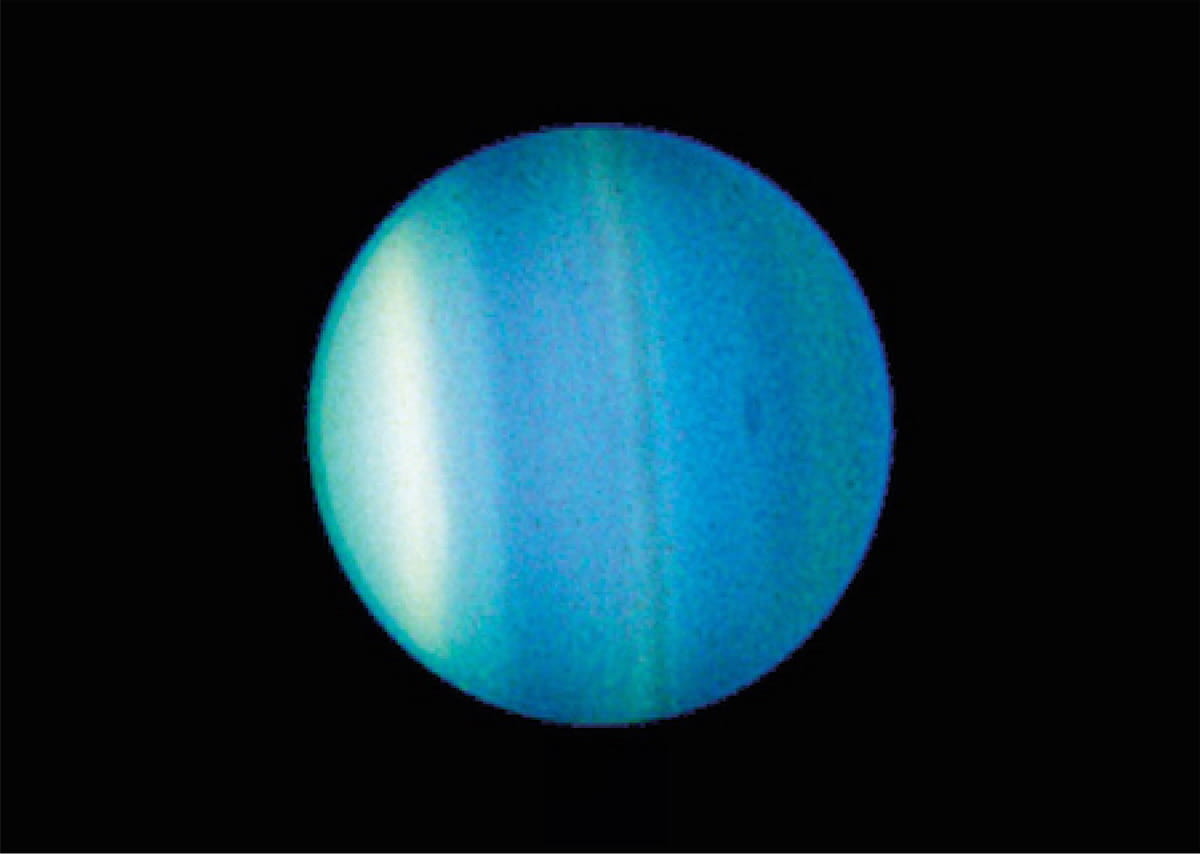Distant and enigmatic, Uranus breaks the mold of planetary norms. Discovered in 1781, it was the first planet found with a telescope, an accidental triumph in the annals of space exploration. With its axis tilted at an angle of 98 degrees, it’s the only planet that rolls on its side in orbit, leading to extreme 42-year seasons. Its faint but present rings and methane-rich blue hue add to its allure, making Uranus not just an ice giant, but a giant canvas of cosmic mysteries.
Embark on a journey through 25 compelling facts that shed light on the third largest planet in our solar system and why it continues to intrigue us centuries after its discovery.
1. Uranus: The Sideways Spinning Ice Giant
Spin Uranus on its axis, and you’ll notice it’s markedly different. This giant doesn’t spin like its planetary brethren; it rolls along its orbit. This unique feature was uncovered through telescopic observations and has been a subject of study ever since. Why so sideways? Theories suggest a colossal impact might have knocked it off-kilter during the solar system’s tumultuous past. Uranus’s sideways stance not only defines its day and night cycle but also influences its magnetic field, making it one of the most fascinating planets to study.
This third largest planet has an axial tilt that causes wild seasonal variations. Imagine the bizarre sight – for nearly half a Uranian year, the Sun shines directly over each pole, leaving the other in a prolonged twilight. This extreme tilt gives rise to one of the most extreme planetary climates in our solar system.
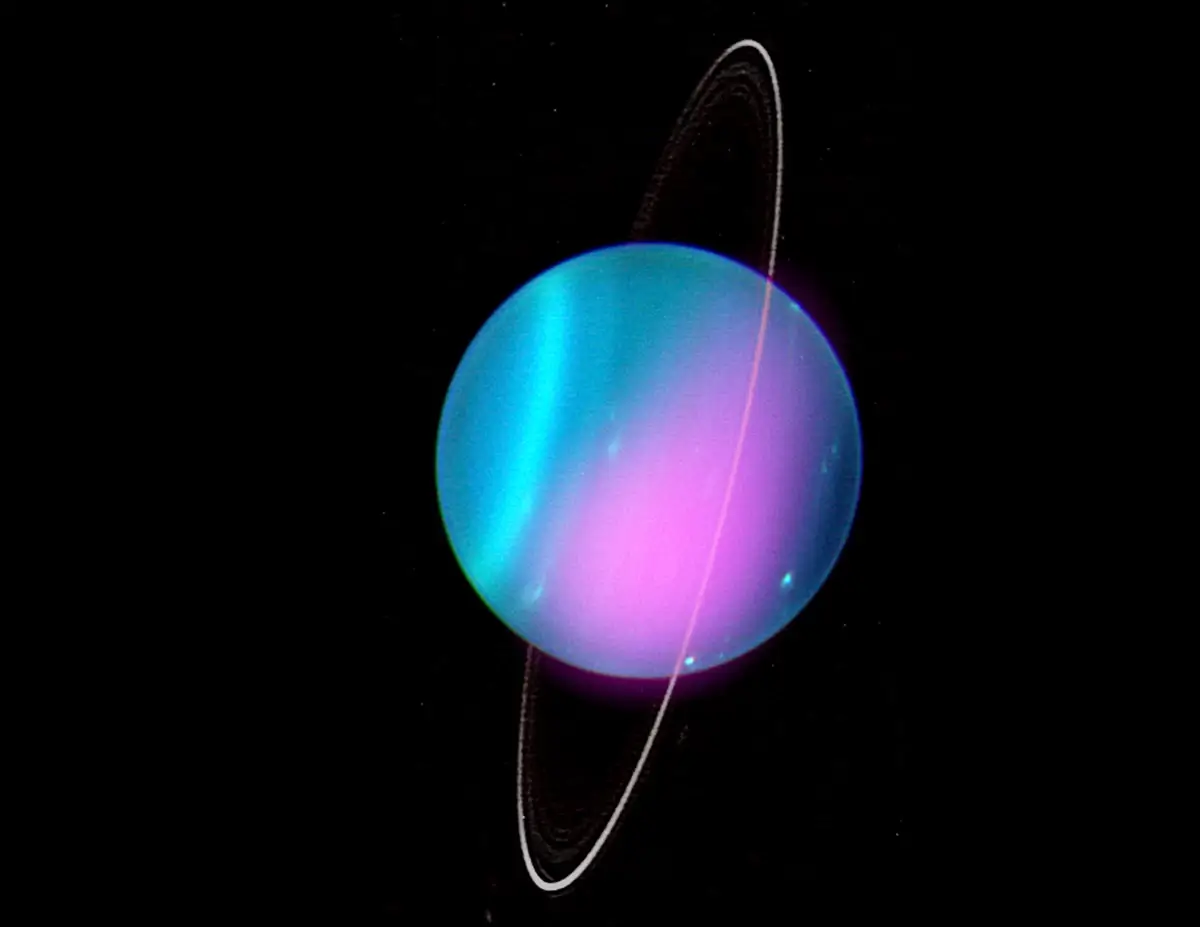
Image: NASA
2. The Discovery: Herschel’s Accidental Triumph
On March 13, 1781, the night sky offered up a new secret to William Herschel. What he cataloged as a comet was later revealed to be a planet – Uranus, the first planet discovered using a telescope. This discovery challenged the ancient belief that Saturn was the outermost planet. Herschel, an accomplished musician turned astronomer, initially named his discovery Georgium Sidus (George’s Star) after King George III of Britain. It wasn’t until 1850 that the planet was officially named Uranus, honoring the ancient Greek deity of the sky.
Herschel’s find extended the known boundaries of our solar system and marked the beginning of modern planetary astronomy. It’s a testament to the ever-evolving nature of scientific discovery and how a single observation can alter our understanding of the cosmos.

William Herschel. Image: ytimg.com
3. The Pale Blue Dot: Unveiling Uranus’s Color
Uranus’s captivating cyan is thanks to its upper atmospheric content of methane gas. When sunlight enters the atmosphere, methane absorbs the red portion of the light spectrum, reflecting back the serene blue that we associate with this distant planet. This discovery, made through spectroscopic studies, offers insight into the atmospheric composition of the ice giant.
The color also hints at the coldest planet’s frigid temperatures, with the upper atmosphere reaching lows of -371 degrees Fahrenheit (-224 degrees Celsius). Despite its tranquil appearance, Uranus’s atmosphere is anything but serene, with winds howling at speeds of up to 900 kilometers per hour. This contrast between appearance and reality is what makes Uranus a subject of endless fascination.
4. A Planet of Extremes: The Coldest of Them All
Uranus holds the title for the lowest temperature ever recorded in our solar system, dipping down to a bone-chilling -371 degrees Fahrenheit. Discovered through infrared measurements, this fact highlights its status as the coldest planet, despite not being the farthest from the Sun. This extreme cold is attributed to Uranus’s lack of an internal heat source, a characteristic that sets it apart from other giant planets.
The planet’s minimal heat emission affects everything from its atmospheric chemistry to its cloud formation. Such freezing conditions offer a unique environment for studying molecular and atmospheric science, making Uranus a frigid laboratory orbiting within our solar system.
5. The Inverted Moon System: Irregular Satellites of Uranus
Among the many moons of Uranus, a subset of irregular satellites stands out for their retrograde, or backward, orbits. These moons, such as Caliban and Sycorax, defy the common direct orbital motion seen in regular moons, suggesting a violent history of capture rather than peaceful in-situ formation. The study of these irregular satellites is a peek into the early solar system’s chaotic environment, potentially filled with wandering celestial bodies.
These backward-orbiting bodies challenge our understanding of the processes that shaped the early solar system. They may hold the key to discovering the migratory behavior of planets and the mechanism behind moon capture. As such, these irregular satellites are more than just outliers; they are chronicles of the solar system’s formative years.
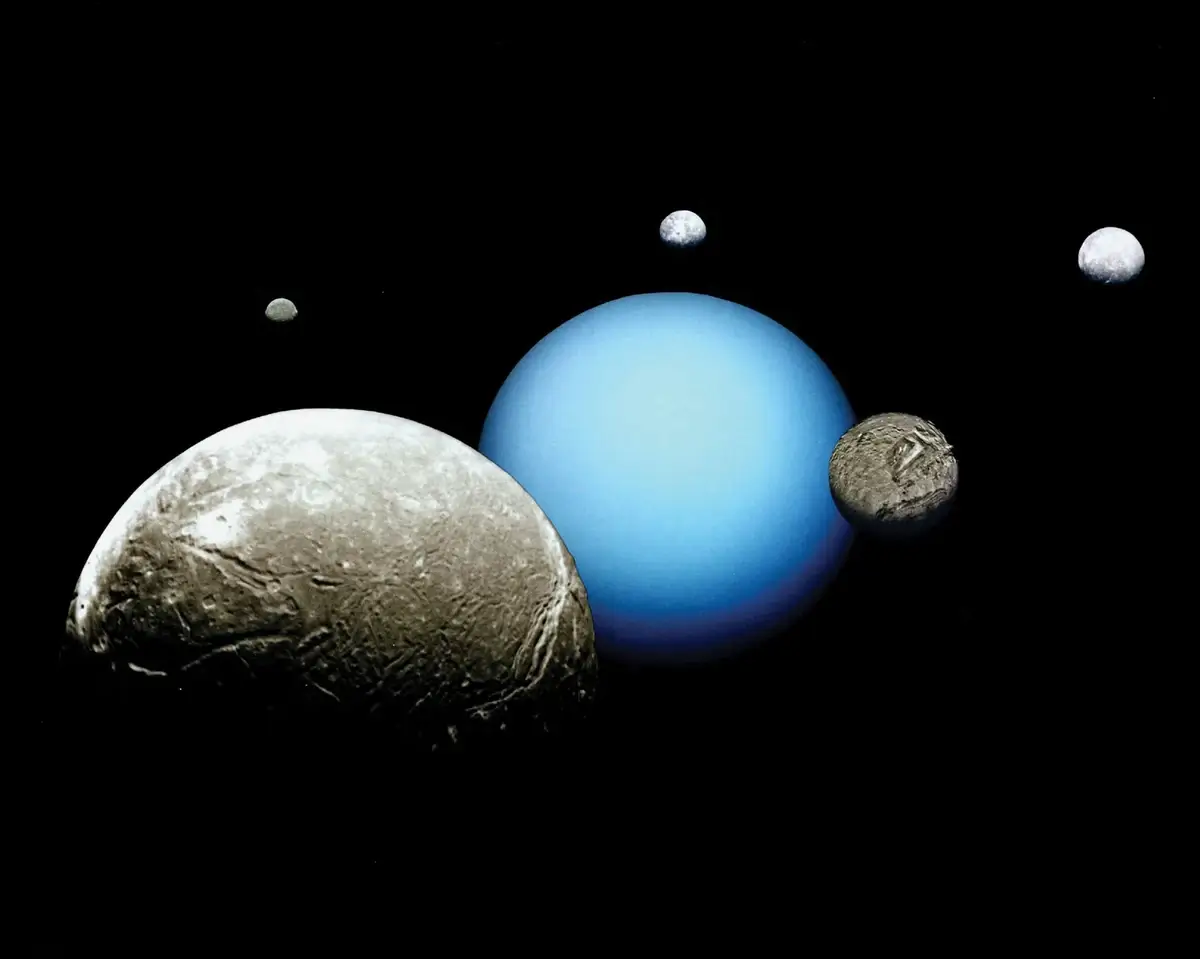
Image: Britannica
6. Rings of Ice: Exploring the Uranian Ring System
Discovered in 1977, Uranus’s rings are a relatively new find in the field of astronomy. Unlike the prominent rings of Saturn, the rings of Uranus are dark and narrow, composed of large particles ranging from dust to boulder-sized chunks. These particles are thought to be remnants of moons that shattered due to high-velocity impacts.
The Epsilon Ring, the brightest and densest of Uranus’s rings, was the first to be discovered. It’s made up of icy boulders coated with a dark material. These rings are a testament to the dynamic and sometimes violent history of the solar system.

Image: Lawrence Sromovsky, University of Wisconsin-Madison/W.W. Keck Observatory
7. The First of Its Kind: Uranus Sparks a Naming Revolution
Uranus is the first planet to be named after a figure from Greek mythology, breaking millennia-old tradition of naming planets after Roman deities. Its name, selected years after its discovery, honors the Greek god of the sky, Uranus, the grandfather of Zeus. This decision kickstarted a new convention in astronomical nomenclature.
The name also marked a shift in identifying celestial bodies, highlighting the expansion of our known universe and the need for a broader lexicon to categorize its contents. It’s a fact that Uranus’s naming paved the way for subsequent discoveries to draw from a wider cultural pool, enriching the astronomical heritage.
8. A Long Journey: One Uranian Year
Uranus completes an orbit around the Sun once every 84 Earth years. Given its extreme axial tilt, each of its poles is engulfed in 42 years of continuous sunlight, followed by an equal time of darkness. This fact makes the concept of a year on Uranus unlike anywhere else in the solar system. Astronomers were able to calculate Uranus’s orbital period through careful observation of its motion across the night sky and applying Kepler’s laws of planetary motion.
This elongated orbit results in prolonged seasonal changes that are still not fully understood, making Uranus a subject of ongoing study and interest in the astronomical community.
9. The Lightest of Giants: Uranus’s Low Density
Despite being categorized as a giant planet, Uranus has the lowest density of all the giants in our solar system—just about 1.27 grams per cubic centimeter. It’s so light because it’s primarily made up of lighter elements like hydrogen and helium, with a small rocky core and a mantle of water, ammonia, and methane ices. This interesting fact was deduced through both Voyager 2 data and ground-based observational campaigns measuring the planet’s size, mass, and gravitational influence.
Uranus’s low density also implies that it doesn’t have a well-defined solid surface. Instead, spacecraft would encounter increasing pressure and temperatures as they dive into the planet’s gaseous layers.
10. The Great Dark Spot: Witnessing Uranian Storms
In 1986, the Voyager 2 spacecraft discovered a significant dark blemish on Uranus’s surface, reminiscent of Jupiter’s Great Red Spot. This feature, known as the Great Dark Spot, was a massive storm, the first of its kind observed on Uranus. Scientists, utilizing the Hubble Space Telescope and sophisticated computer modeling, have tracked these storms, noting that they can reach speeds of up to 900 kilometers per hour.
These tempestuous weather patterns are thought to be seasonal, related to the planet’s extreme axial tilt, and their transient nature adds to the complexity and dynamism of Uranus’s atmosphere.
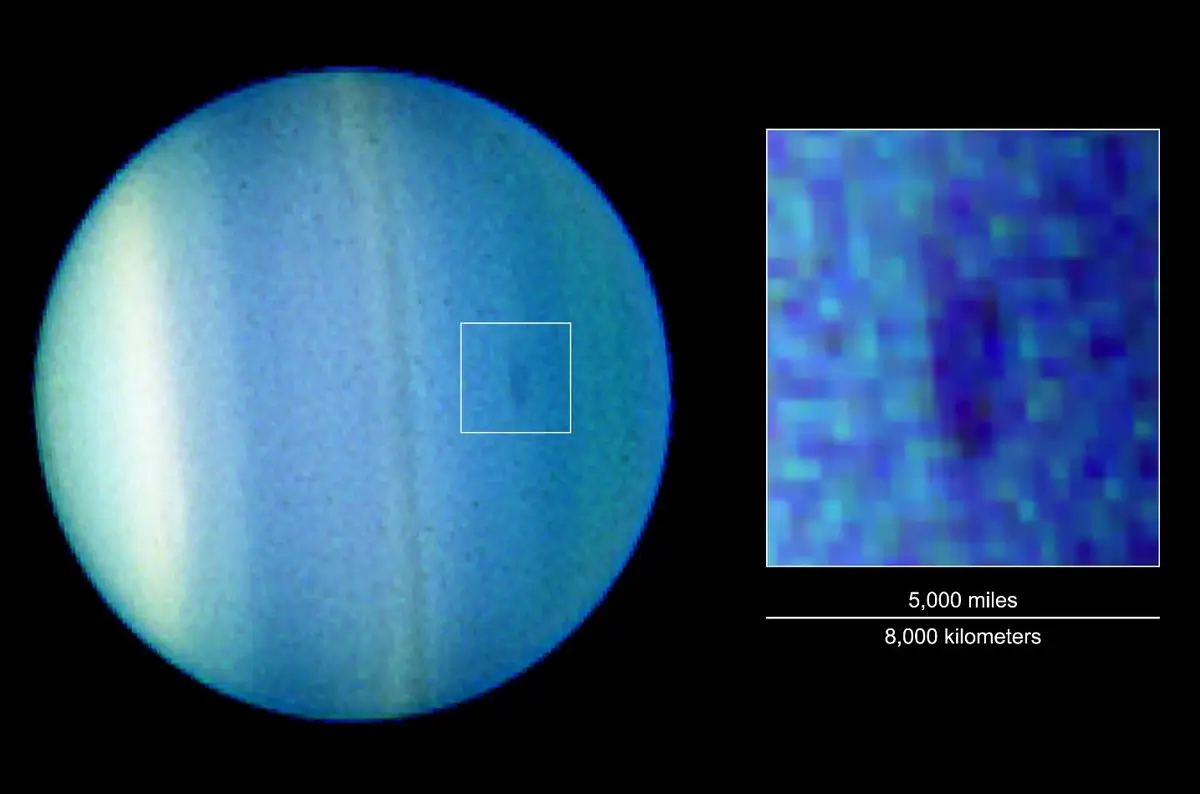
Image: exoplanetscience.org
11. Voyager 2’s Flyby: A Close Encounter with Uranus
The Voyager 2 encounter with Uranus in January 1986 remains the only close-up exploration of the planet to date. During the flyby, the spacecraft provided unprecedented images and data, revealing two new rings, ten new moons, and a strangely tilted magnetic field. The mission offered insights into the temperature and composition of the Uranian atmosphere, information on its rings, and detailed photos of its moons.
This flyby, lasting mere hours, greatly expanded our knowledge of this distant planet and remains a pivotal moment in space exploration. The data gathered by Voyager 2 continues to be vital for researchers piecing together the story of this ice giant.
12. A Dance of Moons: Uranus’s Natural Satellites
Uranus is accompanied by a complex system of moons, with 27 confirmed natural satellites named primarily after characters from the works of William Shakespeare and Alexander Pope. These moons vary greatly in size and composition, with the largest, Titania, measuring about 1,578 kilometers in diameter. The discovery of these moons has been staggered over centuries, with the earliest, Titania and Oberon, discovered by William Herschel in 1787, and the most recent, Cupid, found in 2003 using the Hubble Space Telescope.
The orbital dance of these moons, influenced by Uranus’s significant tilt, presents a fascinating dynamical system for astronomers to study. Understanding their interactions helps us learn more about the evolution and history of the solar system.
13. Uranus’s Sound of Silence: The Quiet of the Outer Solar System
The realm of Uranus is one of profound silence. Far from the Sun, the solar winds that buffet the inner planets diminish significantly, creating a peaceful cosmic environment. This relative calm allows for the existence of Uranus’s delicate ring system, which might otherwise be disrupted by stronger solar activity. Such tranquility in the outer solar system provides a stable backdrop for the long-term study of planetary atmospheres and ring dynamics.
The quiet of Uranus’s surroundings also means that electromagnetic disturbances are infrequent, allowing for clearer detection of signals from the planet itself. As such, Uranus offers an almost pristine laboratory for studying the intrinsic properties of an ice giant’s magnetosphere and ionosphere, free from the Sun’s overpowering influence.
14. The Hidden Ocean: Uranus’s Subsurface Secrets
Beneath the icy exterior of Uranus, there may lie a vast ocean of water mixed with ammonia, enveloping a rocky core. While the existence of this subsurface ocean is not directly observed, its presence is inferred from the planet’s flattened shape and the way its gravity affects orbiting spacecraft and moons. The pressure within this ocean would be immense, possibly producing exotic forms of ice unlike anything on Earth.
This hypothesis about Uranus’s interior provides exciting possibilities for astrobiology and planetary geology, offering a glimpse into the complex inner workings of ice giants.
15. Uranus in Pop Culture: From Literature to Television
Despite its occasionally comedic reputation in pop culture due to the phonetic pronunciation of its name, Uranus has had a significant and multifaceted presence in various media, often representing the zenith of the unknown and the allure of discovery. In literature, it’s been featured in numerous works of science fiction, such as Kurt Vonnegut’s “The Sirens of Titan,” where it serves as a pivotal location within the narrative, symbolizing the vast and untapped potential of space exploration. Similarly, in David Lindsay’s “A Voyage to Arcturus,” Uranus is depicted as a stepping stone in the cosmic journey, further cementing its role as a gateway to the broader universe.
On television, Uranus has been a subject of interest in both documentary and fictional realms. Science shows like “The Universe” on the History Channel have dedicated episodes to unraveling the planet’s mysteries, educating audiences on its unusual characteristics and its place within our solar system. In the realm of animation, the name and image of Uranus have been leveraged for both humor and educational content, engaging viewers with a blend of entertainment and factual science. This dual presence in pop culture not only demonstrates the planet’s ability to captivate and intrigue but also its utility as an educational tool that can introduce complex astronomical concepts in an accessible manner.
16. The Windy Giant: Unraveling Uranus’s Atmospheric Fury
Uranus’s atmosphere is a turbulent place, with the fastest wind speeds reaching up to 900 kilometers per hour. These winds whip around the planet in a retrograde direction, opposite to the planet’s rotation. This phenomenon was measured by tracking the motion of clouds with the help of Voyager 2 data and Earth-based telescopes. The underlying cause of these high-speed winds remains a topic of research, but it is believed to be related to the heat distribution in the planet’s atmosphere.
These extreme conditions challenge our understanding of atmospheric dynamics and emphasize the unique nature of Uranus in our solar system. The windy giant continues to stir scientific curiosity with its atmospheric secrets.
17. Magnetic Puzzles: Uranus’s Unusual Magnetic Field
Uranus’s magnetic field is unlike any other in the solar system. It is not only significantly offset from the planet’s rotation axis but is also tilted at a 59-degree angle to it. Discovered by Voyager 2, this peculiar alignment results in a lopsided magnetic field that causes the planet’s magnetosphere to tumble unevenly as it interacts with the solar wind.
The irregularity of this field suggests a complex fluid motion within the planet’s interior, which could be due to the movement of conductive materials like water, ammonia, and methane under high pressure. Uranus’s magnetosphere provides an extraordinary laboratory for studying magnetic field generation in planets.
18. The Gas and Ice Composition: Uranus’s Building Blocks
Uranus is often termed an “ice giant” due to its large size and the composition of its interior, which consists of a mixture of water, methane, and ammonia ices above a small rocky core. When we refer to “ices,” we are speaking of compounds that would be gaseous on Earth but exist in a frozen state due to the extreme cold temperatures of Uranus.
These materials are not only vital for the planet’s structure but also play a crucial role in its thermal emission and the color of its atmosphere. The precise balance of these elements gives Uranus its distinct characteristics and sets it apart from the other gas giants in our solar system.
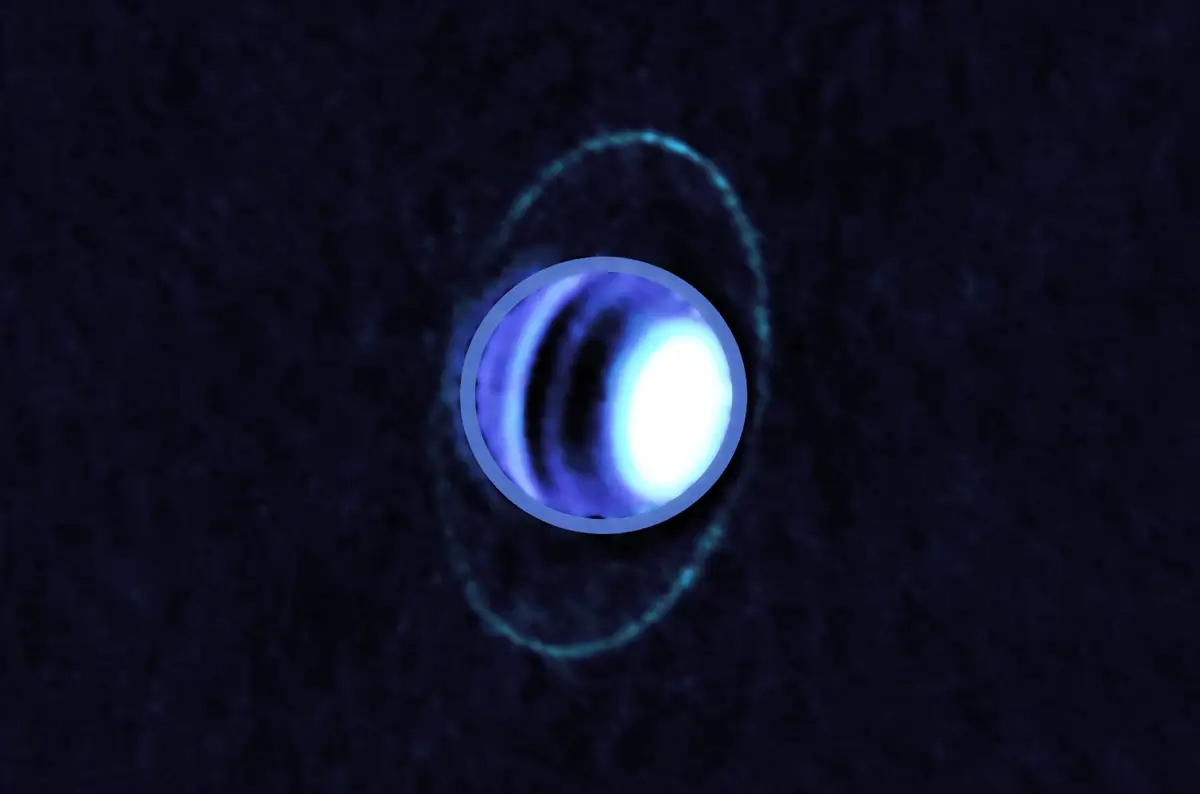
In December 2017, the Atacama Large Millimeter/submillimeter Array (ALMA) captured a combined image of Uranus’s atmosphere and rings in radio wavelengths. The image reveals contrasting dark and bright areas, indicating the varying composition of the planet’s atmosphere. The dark stripes are areas rich in molecules that absorb radio waves, especially hydrogen sulfide gas, while the lighter areas, including a prominent spot at the north pole, are regions with a scarcity of such molecules. This image was made possible through the collaboration of ALMA with ESO, NAOJ, and NRAO, and credited to E. Molter and I. de Pater.
19. The Lopsided Orbit: Dynamics of Uranus’s Path
Uranus’s orbit around the Sun is unique as it features a high orbital inclination and eccentricity compared to other planets. Its path is tilted about 0.77 degrees off the solar system’s plane, known as the ecliptic, and its orbit is more elliptical than that of most other planets. This means that Uranus’s distance from the Sun varies more throughout its orbit, which influences the planet’s seasonal changes.
These orbital characteristics were determined through centuries of astronomical observations and calculations, leading to a deeper understanding of the dynamical processes governing the planet’s long, 84-year journey around the Sun. The peculiarities of Uranus’s orbit add another layer to its enigmatic nature.
20. Seasonal Changes: Uranus’s Extreme Seasons
The extreme axial tilt of Uranus leads to some of the most peculiar seasonal changes in the solar system. Each pole gets prolonged periods of sunlight and darkness throughout Uranus’s 84-year orbit, resulting in seasons that last for over two decades. The intensity of these seasons was observed through changes in brightness, atmospheric activity, and even the color of the planet, as recorded by the Keck Observatory.
These prolonged seasons affect not just the surface, but also the atmospheric temperatures and winds, creating an ever-changing environment. The study of these seasonal variations gives scientists valuable insights into atmospheric physics and climate modeling on other planets.
21. The Vanishing Act: Uranus’s Disappearing Moons
In a cosmic magic trick, some of Uranus’s moons are gradually disappearing. Due to their dark surfaces and the faintness of the rings they are associated with, these moons are challenging to observe from Earth. As they are small and share similar colors with the background space, they are occasionally lost to observers, leading to the term “disappearing moons.”
This has led to a greater interest in understanding the dynamics of these small satellites, their interaction with Uranus’s ring system, and the mechanisms behind their dark surfaces. Further study could reveal more about the processes at play in the lesser-known regions of our solar system.
22. A Geological Enigma: Uranus’s Surface Features
Uranus itself is largely an enigma when it comes to its surface features. The planet’s surface is hidden beneath a thick layer of clouds, and the lack of a solid surface makes direct geological observations impossible. However, the motions of these clouds have been studied to infer the dynamics of the interior, revealing an active and varied atmosphere.
The few visible features include the Great Dark Spot and smaller dark spots, thought to be storms in the upper atmosphere. These features come and go, indicating a lively and changeable weather system. Understanding these atmospheric phenomena provides clues to the geological processes at play within this ice giant.
23. The Many Names of Uranus: From Myth to Astronomy
The naming of Uranus is a journey through history and mythology. Initially known as “Georgium Sidus” after King George III by its discoverer William Herschel, the name didn’t stick due to its lack of classical resonance. The name “Uranus” was proposed by astronomer Johann Elert Bode as a way to honor the ancient Greek gods, fitting with the nomenclature of other planets.
The adoption of the name Uranus, the Greek god of the sky, set a precedent for the naming of newly discovered celestial bodies. This decision reflects the blend of scientific discovery with the rich tapestry of cultural and mythological traditions.
24. The Ghostly Glow: Auroras on Uranus
The auroras on Uranus are a ghostly and elusive phenomenon. Unlike Earth, where auroras are a common occurrence, the auroras on Uranus are difficult to detect and observe. Caused by the interaction of solar wind with the planet’s magnetic field, these light displays were first captured by the Hubble Space Telescope in 2011.
The unique magnetic field of Uranus, with its large offset and tilt, creates auroras that are not aligned with the poles like on Earth, leading to a spectacular and unpredictable light show. Studying these auroras helps scientists learn more about the planet’s atmosphere and magnetic environment.
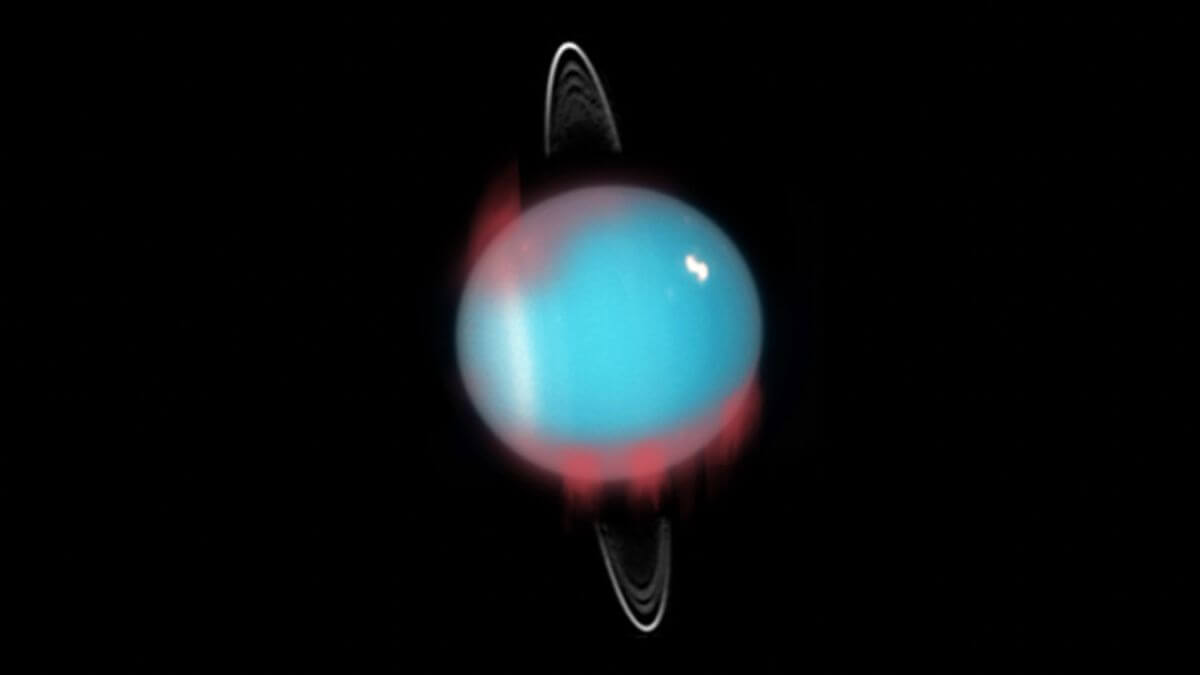
Image: NASA/ESA/M. Showalter (SETI Institute)
25. Uranus’s Future Exploration: What Lies Ahead?
Despite being an intriguing subject, Uranus has been relatively unexplored compared to other planets in the solar system. However, future missions to Uranus are on the wish lists of many planetary scientists. Proposals for these missions include orbiters, flybys, and even probes to study the atmosphere directly. The objectives would be to better understand the planet’s structure, atmosphere, magnetic field, and moons.
There’s also interest in studying Uranus’s potential subsurface ocean and its implications for astrobiology. With advancements in technology, the next few decades could see new missions launched to unravel the mysteries of this distant ice giant.
FAQ
Is Uranus the Coldest Planet?
Yes, Uranus holds the title of the coldest planet in our solar system. Despite not being the furthest from the sun, its minimum atmospheric temperatures can plunge to a frigid -224 degrees Celsius (-371 degrees Fahrenheit). This is due to its lack of an internal heat source, unlike other gas giants which emit significant amounts of internal heat.
How Many Earths Can Fit in Uranus?
Uranus is significantly larger than Earth. If you were to compare the two, about 63 Earths could fit inside Uranus if it were hollow. This is based on the volume comparison; Uranus’s volume is roughly 63 times that of Earth’s.
How Did Uranus Get Its Name?
Uranus is the only planet in the solar system named after a figure from Greek mythology, rather than Roman. The name was suggested by Johann Elert Bode, a German astronomer, who proposed it should be named for the Greek god of the sky, Ouranos. This name was chosen to complement the classical mythology-themed nomenclature of the other planets.
How Many Moons Does Uranus Have?
Uranus has 27 known moons, each named after characters from the works of William Shakespeare and Alexander Pope. The largest of these moons are Titania, Oberon, Umbriel, Ariel, and Miranda. They range in size and composition, with some being ice-rich bodies while others are rocky or a mixture of both.
Who Discovered Uranus?
Uranus was discovered by German-born British astronomer William Herschel on March 13, 1781. His discovery was serendipitous while he was conducting a survey of the sky with his telescope. Initially mistaking it for a comet, he eventually realized it was a new planet, the first to be discovered with a telescope.
What Are Uranus Rings Made Of?
The rings of Uranus are made up of dark, relatively large particles ranging in size from dust to boulders. They are thought to be the remnants of broken moons or other celestial bodies that were shattered by high-velocity impacts. The rings were discovered in 1977 and consist of a combination of ice and rock.
How Old is Uranus?
Uranus is estimated to be about 4.5 billion years old, roughly the same age as the rest of the solar system. It formed from the protoplanetary disk of gas and dust that surrounded the young sun and has evolved over billions of years to its current state.
Why is Uranus So Big?
Uranus’s size is a result of the accumulation of gas and dust during its formation in the early solar system. Its rapid rotation likely caused the planet to flatten slightly at the poles and become swollen at the equator, giving it a large equatorial diameter. Uranus’s mass allowed it to hold onto a thick atmosphere, which contributes to its size.
What Are the Top 5 Elements of Uranus?
The top five elements in Uranus’s composition are hydrogen, helium, methane, water, and ammonia. The planet’s atmosphere is mostly made up of hydrogen and helium, while methane contributes to its blue color. Water and ammonia make up much of the icy materials in its mantle.
How is Uranus Born?
Uranus was born from the solar nebula, the cloud of gas and dust left over from the sun’s formation. As the nebula collapsed under gravity, material began to coalesce and form planets. Uranus formed in the colder outer regions, allowing it to gather its gases and ices, which defined its composition as an ice giant. Over time, its gravity shaped it into a spherical planet, and it settled into its current orbit around the sun.


